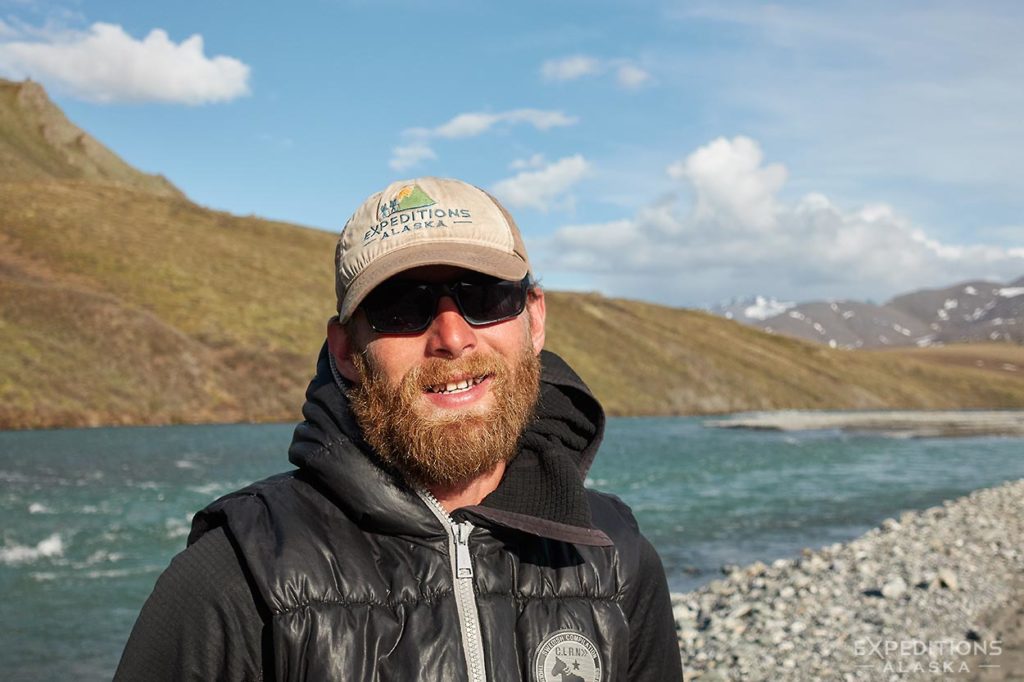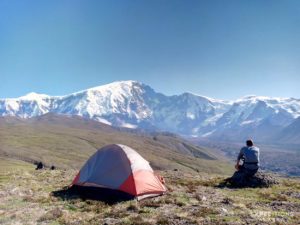Hey Folks,

I think one of the most commonly misunderstood phrases/ideas in the backcountry is “layering” (along with “if your feet are cold, put a hat on your head”). I’m not about to tell you to layer, but I do want to shed a little light on what all this means.
The single most common ‘mistake’ (I use that term very loosely; it’s far too subjective to be seriously called a mistake) I see people make on their Alaska Backpacking Trip is bringing a whole bunch of thin to medium layer in the hope of staying warm. Baselayers, polypro layers, lightweight fleece, etc are all great pieces of gear, but you don’t need to swamp your pack down with them. You need, at most, 2.
Rarely, if ever, do I need to hike with more than one layer on my torso; if it’s super warm, I’ll wear a polypro t-shirt. Generally, though that single layer is almost always a single long-sleeved nylon (tight-weave so it’s bug proof) shirt. You know the generic ‘safari-style’ shirt you find in any outdoor store; dawky looking, button-down, collar. and rolled up sleeves. If it’s raining, I’ll throw a thin, breathable waterproof-breathable shell over my shirt. That’s it.
When the temperatures really get down, say, in the 30’s, I’ll add a layer to that ; for example, on a descent, in blowing wind and rain, after we stop at the pass after a climb and take a break, I’ll throw a light fleece (usually my Patagonia R1) over my shirt, under my rain shell. When we get moving, downhill, I’ll leave my R1 on, and maybe my fleece/wool hat. I know when I’m hiking downhill, I’m not burning energy too much, and not throwing out as much excess heat. So that layer of insulation comes in handy. But as soon as we level off, or start climbing again, I almost always lose that layer.
What I need insulation for is (a) when it’s really, really cold (rare) or (b) when I’m inactive, and so not generating a ton of heat myself. In other words, every evening in camp, morning in camp, taking a lunch break or a rest stop on the hike. (b) is far, far, far more common than (a). (b) happens every day. (a) happens maybe once a summer.
See a picture of Rhane guiding in the Arctic National Wildlife Refuge above. He’s hunkered down for some chilly winds in a coupe of baselayers and a puffy vest over the top of that. Toasty and warm, but not what he’d wear once we’re on the move again.
So I don’t want to bring 3 baselayer garments and 4 lightweight fleece pullovers. I want a decent baselayer, like a light/medium-weight wool/fleece/polypro pullover, and I want something warm. My go to piece is my Montbell Down jacket; specifically, the Ex Light Down Jacket – this keeps me warm. But I can’t tell you the last time I actually hiked in it; it’s way too warm for that. But I don’t get cold sitting in the cook tent in the evening at supper time, when the temperatures might drop to 35 degrees F, and the cold damp air seeps in through your skin.
Conversely, adding 4 relatively light, thin, polypro pullover-style base layer items together won’t keep you warm.
For my legs, I bring one heavyweight pair of long johns, Patagonia Capilene 4, and, if I want to be a little extra cozy, maybe a lighter weight wool/capilene pair to sleep in – but those are an optional extra I choose or leave behind depending on how I feel. I hike in long pants most of the time, and it’s rare that, even when the temps are low and I’m inactive, that my long johns, my hiking pants and my rain shell pants aren’t enough to keep my legs warm.
I carry (usually) a pair of fleece gloves, but almost never, ever wear them. And I carry a fleece/wool hat that I wear in camp in the evening, or at a lunch break on a cold, nasty weather day.
I really don’t see the need or point in bringing lots of light-weight, thin (meaning light/mediumweight) baselayer style items; and virtually every time I see someone do so, they end up being too cold.
You want warmth when you’re not hiking; and that is best served by a puffy down or synthetic fill jacket.
The last thing I’ll add here: do what works for you. We all feel and respond to temperature differently, our bodies run differently at different temperatures, and what works well for me at 45˚F might not be ideal for you. And vice versa.
Cheers
Carl



